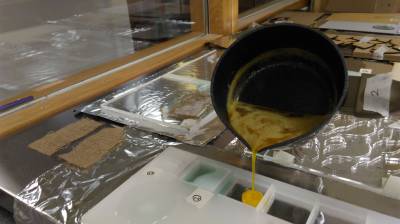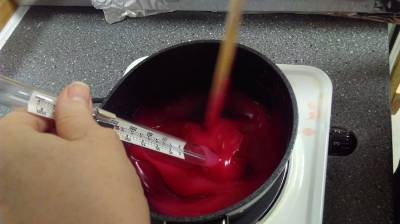Bootcamp 2017 Paris - Linda Wanders
Bioplastic experiment
Together with Inger Le Gué we tried out 4 different recipes of making bioplastics. Each recipe has been colors in a different shades of food color (to later know which was which). We tied casting on different surfaces. Trying casting on acrylic, wood, MDF, cardboard, aluminium foil and baking paper. It was lots of fun! Though we did not realize beforehand that cooking these ingredients would smell so bad. Our main problem with this project was getting started. Turns out finding ingredients in Iceland is a hard thing, and took time running all over town.
Notes
Less glycerol will create a more brittle but harder material, more glycerol will make a flexible and softer sheet. You can get different hardness (or elasticity) depending on the quantities of gelatin, glycerol and water you put inside your mixture. You can also change the opacity and create foam with spitting air inside the heated mix.
The drying time depends on several factors : the dosages of water, gelatin and glycerol put in the mixture ; the thickness of your final product and also the temperature and humidity of the room in which you made it dry. It's best to wait a week of drying before taking off the bioplastic. If you remove it too soon, it's most likely that it will deform by continuing to dry.
In order to have the shrinking effect have a frame of the shape you want and cast the bioplastic on glass. Let dry for 2-3 days. Lift up and let shape dry with the frame letting the air to pass from both sides.
links
tutorial http://materiability.com/portfolio/bioplastics-2/
inspiration https://www.instagram.com/p/BYD5k3uHRkI/
example project experiments http://urbanbeelab.okno.be/doku.php?id=bioplastics#lightbox[gal-f361cd339deeb2d5d7c9498824b7]/36/
Experiment 1 | 180 ml water, 9 gr. glycerol, 36 gr. gelatin, drop of blue food coloring.
- First mix the cold water and the gelatin powder in the pan without heating.
- Gradually, the mixture turns into a granular yellow pale paste.
- Then start heating the preparation while stirring slowly so that there are no lumps.
- Once the preparation has become liquid and homogeneous add the glycerin into the mixture.
- Continue mixing and heating until you begin to see a whitish deposit on the surface of your mixture. If you want a transparent matter you have to remove completely this white foam with a spoon or you can also make more foam by adding air inside your mix.
- Now pour your mixture into the mold or the prepared surface.
Experiment 2 | 150 ml water, 12 gr. glycerol, 36 gr. gelatin, drop of yellow food coloring.
Experiment 3 | 150 ml water, 22,5 gr. glycerol, 22,5 cornstarch, 15 ml vinegar, drop of pink food coloring.
Experiment 4 | Agar agar recipe, 100 ml water, 24 gr agar agar, 8 gr glycerol, drop of green food coloring.
Overview



















